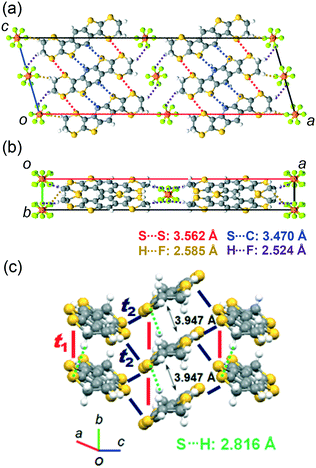Two-dimensional radical–cationic Mott insulator based on an electron donor containing neither a tetrathiafulvalene nor tetrathiapentalene skeleton†
Tomofumi
Kadoya
 *a,
Shiori
Sugiura
*a,
Shiori
Sugiura
 *b,
Keishiro
Tahara
*b,
Keishiro
Tahara
 a,
Toshiki
Higashino
a,
Toshiki
Higashino
 c,
Kazuya
Kubo
a,
Takahiko
Sasaki
c,
Kazuya
Kubo
a,
Takahiko
Sasaki
 b,
Kazuo
Takimiya
b,
Kazuo
Takimiya
 de and
Jun-ichi
Yamada
*a
de and
Jun-ichi
Yamada
*a
aGraduate School of Material Science, University of Hyogo, 3-2-1 Kouto, Kamigori-cho, Ako-gun, Hyogo 676-1297, Japan. E-mail: kadoya.t@sci.u-hyogo.ac.jp; yamada@sci.u-hyogo.ac.jp
bInstitute for Materials Research, Tohoku University, 2-1-1 Katahira, Aoba-ku, Sendai 980-8577, Japan. E-mail: s.sugiura@imr.tohoku.ac.jp
cNational Institute of Advanced Industrial Science and Technology, Tsukuba, Ibaraki 305-8565, Japan
dEmergent Molecular Function Research Team, RIKEN Center for Emergent Matter Science (CEMS), Wako, Saitama 351-0198, Japan
eDepartment of Chemistry, Graduate School of Science, Tohoku University, Aoba-ku, Sendai, Miyagi 980-8578, Japan
First published on 13th July 2020
Abstract
We report the structure and physical properties of a new radical–cationic Mott insulator θ-(BEDT-BDT)PF6 (BEDT-BDT: benzo[1,2-g:4,5-g′]bis(thieno[2,3-b][1,4]dithiin)). The crystal structure belongs to a monoclinic system with a 1![[thin space (1/6-em)]](https://www.rsc.org/images/entities/char_2009.gif) :
:![[thin space (1/6-em)]](https://www.rsc.org/images/entities/char_2009.gif) 1 donor/anion ratio. Based on this composition, the salt is considered a half-filled Mott insulator, in which the BEDT-BDT molecules form a θ mode arrangement. Owing to the strong electron correlation, the temperature dependence of the resistivity exhibits semiconducting behaviour. The static magnetic susceptibility first follows the Curie–Weiss law down to 15 K, but then follows the two-dimensional (2D) triangular Heisenberg model with J = 7.5 K below 15 K. Even at 2 K, this salt is paramagnetic and no magnetic order is formed. The tight-binding band calculation reveals a 2D Fermi surface. It is remarkable that θ-(BEDT-BDT)PF6 forms a 2D electronic structure without any 1,3-dithiol-2-ylidene units, unlike tetrathiafulvalene and tetrathiapentalene donors.
1 donor/anion ratio. Based on this composition, the salt is considered a half-filled Mott insulator, in which the BEDT-BDT molecules form a θ mode arrangement. Owing to the strong electron correlation, the temperature dependence of the resistivity exhibits semiconducting behaviour. The static magnetic susceptibility first follows the Curie–Weiss law down to 15 K, but then follows the two-dimensional (2D) triangular Heisenberg model with J = 7.5 K below 15 K. Even at 2 K, this salt is paramagnetic and no magnetic order is formed. The tight-binding band calculation reveals a 2D Fermi surface. It is remarkable that θ-(BEDT-BDT)PF6 forms a 2D electronic structure without any 1,3-dithiol-2-ylidene units, unlike tetrathiafulvalene and tetrathiapentalene donors.
Introduction
Mott insulators are key compounds in the development of molecular functional materials. A Mott insulator has a sufficient carrier concentration to present metallic conductivity but is in a state in which carriers cannot move due to Coulomb repulsion. In such an electronic state, a dramatic change in the physical properties can be triggered by breaking the Mott state with a slight external force such as pressure, field-effect, or light irradiation.1 In this regard, the dimensionality of the electronic structure of the Mott insulator is important. Even if a Mott transition is induced by an external force, in a one-dimensional (1D) Mott insulator, an insulating phenomenon attributed to 1D instability is likely to occur.2 Therefore, two-dimensional (2D) Mott insulators have been frequently used to develop new organic functional systems.3 It should be mentioned that high-temperature superconductors of copper oxide compounds have also been created from 2D Mott insulators.4In molecular conductors, radical–cation (RC) salts consisting of a purely organic donor combined with an inorganic anion are the most commonly studied. As the inorganic anion has a closed-shell electronic structure, the physical properties of the RC salt depend on the electronic state of the organic donor. Many RC salts including organic Mott insulators use π-electron donors that contain at least one 1,3-dithiol-2-ylidene (DY) unit.5 In particular, donor molecules with tetrathiafulvalene (TTF) and tetrathiapentalene (TTP) cores, which consist of two DY units, have frequently been used in RC salts (Chart 1a). If electron donors different from the conventional molecular skeleton are used, the development of RC salts with an unprecedented functionality is expected. However, no promising electron donors other than TTF and TTP derivatives have been reported over a long period of time.
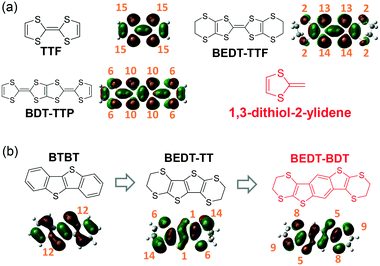 | ||
| Chart 1 (a) Molecular structures of DY-based π-electron donors. (b) Molecular design of BEDT-BDT from BTBT. The orange numbers represent the contributions (%) of the sulfur atoms to the HOMO. | ||
To address this issue, we have been developing RC salts using π-donors with non-DY skeletons.6 In this regard, high performance p-type semiconductors as organic transistors are attractive for donor components in RC salts. Although the method of producing conduction carriers is different, transistor molecules have the potential to be adapted as molecular conductors. We have reported that the RC salt (BTBT)2XF6 (BTBT: [1]benzothieno[3,2-b][1]benzothiophene, Chart 1b, which has the basic skeleton of an excellent p-type semiconductor)7 exhibits high conductivity and a high power factor as a thermoelectric compound.8 All the BTBT-based RC salts that we have reported so far have a 1D electronic structure.6,8,9 Owing to their 1D instability, these RC salts show an insulating state below 50 K.
In order to increase the dimensionality of RC salts, the introduction of an ethylenedithio group has been found to be an effective method.10 According to this strategy, a molecule with ethylenedithio groups introduced into the thieno[3,2-b]thiophene skeleton, namely, 2,3:5,6-bis(ethylenedithio)thieno[3,2-b]thiophene (BEDT-TT), has been reported (Chart 1b).11 However, the authors have reported that RC salts using BEDT-TT could not be developed. Furthermore, the highest occupied molecular orbital (HOMO) of this molecule is not effectively localized on the sulfur atoms in the central thienothiophene moiety, so large intermolecular interactions via short S⋯S contacts would not be expected. This HOMO distribution is disadvantageous for the transport properties of RC salts, as for conventional DY-based donors, it is important that the HOMO is located on the sulfur atoms evenly in the TTF or TTP core (Chart 1a). Thus, we selected benzo[1,2-g:4,5-g']bis(thieno[2,3-b][1,4]dithiin) (BEDT-BDT) with a benzene ring introduced between the thiophene rings of BEDT-TT (Chart 1b). The synthesis and transistor properties of this molecule have been reported.12 As the HOMO is effectively localized on the sulfur atoms throughout the molecule, BEDT-BDT has the potential to form RC salts that have higher dimensionality than our previously reported BTBT-based conductors.
In this study, we successfully developed θ-(BEDT-BDT)PF6 as a novel RC salt and investigated its structural, electrical, and magnetic properties. This salt was found to be a Mott insulator with a 2D electronic structure. It is noteworthy that a 2D radical–cationic Mott insulator can be developed using an electron donor with a non-TTF or a non-TTP skeleton, especially one that does not contain any DY units.
Results and discussion
Fig. 1a shows the crystal structure of θ-(BEDT-BDT)PF6, which consists of alternate layers of BEDT-BDT molecules arranged in the θ-packing mode and layers of PF6− anions. The corresponding crystallographic data are listed in Table S1 (ESI†). One half of the donor and one half of the anion are present in the asymmetric unit, since each of these species lies on a symmetry element. Thus, (BEDT-BDT)PF6 has a donor/anion ratio of 1![[thin space (1/6-em)]](https://www.rsc.org/images/entities/char_2009.gif) :
:![[thin space (1/6-em)]](https://www.rsc.org/images/entities/char_2009.gif) 1, which means that the donor molecule has a charge of +1e and forms a half-filled energy band. Furthermore, the composition ratio indicates that this salt is a Mott insulator. The crystal system is monoclinic with the space group C2/c. As the Z value is 4, there are four BEDT-BDT molecules and four PF6− anions per unit cell (Fig. 1a). As the temperature factor for the fluorine atoms of the PF6− anion is large, the possibility of anion disorder cannot be excluded. Because the physical properties of the RC salt depend mainly on the donor molecule, attention is focused on BEDT-BDT. In this salt, the benzodithiophene moiety of the BEDT-BDT molecule is planar, but the terminal ethylenedithio group is warped. There are two types of H⋯F short contacts (2.585 and 2.524 Å) between the BEDT-BDT molecules and the PF6− anions (Fig. 1a and b). As shown in Fig. 1c, the BEDT-BDT molecules form a uniform stack along the b axis with an interplanar distance of 3.947 Å.
1, which means that the donor molecule has a charge of +1e and forms a half-filled energy band. Furthermore, the composition ratio indicates that this salt is a Mott insulator. The crystal system is monoclinic with the space group C2/c. As the Z value is 4, there are four BEDT-BDT molecules and four PF6− anions per unit cell (Fig. 1a). As the temperature factor for the fluorine atoms of the PF6− anion is large, the possibility of anion disorder cannot be excluded. Because the physical properties of the RC salt depend mainly on the donor molecule, attention is focused on BEDT-BDT. In this salt, the benzodithiophene moiety of the BEDT-BDT molecule is planar, but the terminal ethylenedithio group is warped. There are two types of H⋯F short contacts (2.585 and 2.524 Å) between the BEDT-BDT molecules and the PF6− anions (Fig. 1a and b). As shown in Fig. 1c, the BEDT-BDT molecules form a uniform stack along the b axis with an interplanar distance of 3.947 Å.
Furthermore, a θ-mode arrangement with a dihedral angle of 114.6° is formed between two BEDT-BDT molecules on adjacent stacks (Fig. S1 in the ESI†). A S⋯S short contact (3.562 Å) and a S⋯C short contact (3.470 Å) exist between the donor stacks (Fig. 1a), whereas a S⋯H short contact (2.816 Å) exists within the donor stack (Fig. 1c). The intermolecular transfer integrals estimated from the Amsterdam Density Functional (ADF) program are t1 = −33 meV and t2 = 22 meV.13 These transfer integrals are smaller than those in BEDT-TTF salts with the same θ-mode molecular arrangement,14 which is derived from the inherent properties of the molecule that BEDT-BDT has fewer sulfur atoms than BEDT-TTF.
Fig. 2a shows the temperature dependence of the electrical resistivity, with σ = 3 × 10−1 S cm−1 at room temperature. This relatively low conductivity indicates the strong electron-correlation effect peculiar to a Mott insulator. This is in contrast to previously reported BTBT-based 1D RC salts, which exhibited a high conductivity of more than 1000 S cm−1 at room temperature.6,8,9b θ-(BEDT-BDT)PF6 shows semiconductor-like behavior, where the resistance gradually increases below room temperature. An activation energy of 87 meV is estimated as shown in Fig. 2b.
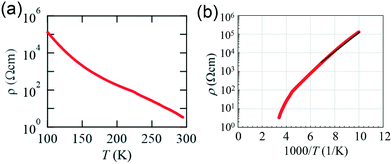 | ||
| Fig. 2 (a) Temperature dependence of the electrical resistivity. (b) Arrhenius plot. The black solid line represents the fitting to estimate an activation energy. | ||
The temperature dependence of the static magnetic susceptibility (χ) is shown in Fig. 3a. A Curie tail with a spin concentration of ∼8%, likely due to impurities or defects, is subtracted from the data. The magnitude of χ is 7.3 × 10−4 emu mol−1 at 300 K, which is of the same order as that for typical molecular conductors. The temperature dependence of χ seems to follow the Curie–Weiss law χ = C/(T − θW) for a wide temperature range above ∼15 K. The χT plot and 1/χ plot give a Curie constant C = 0.19 emu K mol−1 and a Weiss temperature θW = −13 K, respectively (Fig. 3b and c). The spin concentration calculated from C is 50.7% of the total spin localized at each BEDT-BDT site (see the ESI†). This suppression of spin concentration may suggest that the Pauli paramagnetic components are contained owing to the presence of itinerant electrons that produce conductivity at temperatures above 100 K. The negative θW proves that there is antiferromagnetic interaction between spins. Below 15 K, owing to the change from the classical spin to quantum spin properties, the magnetic susceptibility follows the 2D Heisenberg model with 1/2 spins on the triangular lattice. As the temperature decreases, χ is quantum mechanically suppressed and has a broad maximum at ∼6 K. The exchange coupling J = 7.5 K is obtained as a rough estimate using the formula in ref. 15 (inset of Fig. 3a and S3 in the ESI†).
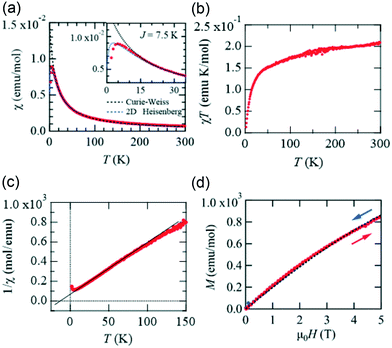 | ||
| Fig. 3 Temperature dependence of (a) magnetic susceptibility. The black and blue dotted lines represent the fitting to the Curie–Weiss law and the 2D triangular Heisenberg model, respectively. (b) χT plot. (c) 1/χ plot. (d) Magnetization curve as a function of magnetic field at 2 K. The red and blue closed circles indicate up and down sweeps, respectively. The black dotted line represents fitting to the modified Brillouin function (see the ESI†). | ||
Fig. 3d shows the magnetization M curve as a function of the magnetic field at 2 K. No characteristic structure and hysteresis loop are observed here for the changes in the magnetic field between ±5 T. This indicates that no magnetic phase transition occurs at 2 K. Note that M can be reproduced using the Brillouin function. It is also implied that the localized spins are paramagnetic even at 2 K. In other words, θ-(BEDT-BDT)PF6 does not undergo antiferromagnetic phase transition, and no magnetic long-range order is formed below 15 K.
Fig. 4 shows the calculated Fermi surfaces for several RC salts.16 Among them, BTBT-based RC salts containing benzothiophene moieties have 1D or quasi-1D electronic structures (Fig. 4a and b). In contrast, θ-(BEDT-BDT)PF6 has a 2D electronic structure because the Fermi surface exists in both the kb and kc directions (Fig. 4c). The bandwidth is 308 meV,17 which is smaller than those of θ-mode BEDT-TTF-based RC salts.14 This small bandwidth suggests that the present salt has a larger density of states than the BEDT-TTF-based salts.
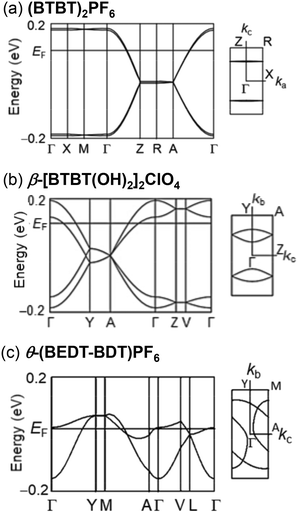 | ||
| Fig. 4 Electronic band structures of (a) (BTBT)2PF6,6 (b) β-[BTBT(OH)2]2ClO4,9a and (c) θ-(BEDT-BDT)PF6. | ||
In neutral radical conductors, there are a few reports of Mott insulators composed of non-DY units, but it has not been clarified whether these compounds form a 2D electronic structure.18 An organic Mott insulator that undergoes a transition to the superconducting state under the application of pressure has a 2D electronic structure.19 Most of the attractive organic systems that exhibit a superconducting transition or a quantum-spin-liquid state are radical–cationic dimer Mott insulators based on BEDT-TTF in a characteristic molecular arrangement called the κ-mode.20
The κ-mode BEDT-TTF-based Mott insulators have a donor/anion ratio of 2![[thin space (1/6-em)]](https://www.rsc.org/images/entities/char_2009.gif) :
:![[thin space (1/6-em)]](https://www.rsc.org/images/entities/char_2009.gif) 1, indicating that one BEDT-TTF molecule has a charge of +0.5e. In the κ-mode arrangement, the BEDT-TTF molecules form a strong dimer structure. Owing to this dimer structure, it is assumed that dimerized BEDT-TTF molecules have +1e (Fig. 5a). On the other hand, θ-(BEDT-BDT)PF6 is characterized in that one BEDT-BDT molecule has a +1e (Fig. 5b). Therefore, θ-(BEDT-BDT)PF6 is a genuine Mott insulator because a hole is localized in a molecule. Very few such genuine Mott insulators have a 2D electronic structure. There has only been one report of an RC salt regarded as a 2D Mott insulator that does not have a κ-mode arrangement, but it also uses BEDT-TTF as a donor molecule.21
1, indicating that one BEDT-TTF molecule has a charge of +0.5e. In the κ-mode arrangement, the BEDT-TTF molecules form a strong dimer structure. Owing to this dimer structure, it is assumed that dimerized BEDT-TTF molecules have +1e (Fig. 5a). On the other hand, θ-(BEDT-BDT)PF6 is characterized in that one BEDT-BDT molecule has a +1e (Fig. 5b). Therefore, θ-(BEDT-BDT)PF6 is a genuine Mott insulator because a hole is localized in a molecule. Very few such genuine Mott insulators have a 2D electronic structure. There has only been one report of an RC salt regarded as a 2D Mott insulator that does not have a κ-mode arrangement, but it also uses BEDT-TTF as a donor molecule.21
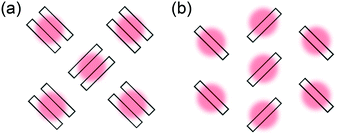 | ||
| Fig. 5 Schematic images of the hole distribution in the Mott insulators for the (a) κ-mode and (b) θ-mode molecular arrangements. | ||
Thus, the most distinctive feature of this study is the construction of a 2D electronic structure for an RC salt without using a DY unit and κ-mode molecular arrangement. In other words, we have demonstrated that a radical–cationic 2D Mott insulator can be developed using components completely different from those used in the conventional molecular design.
Conclusions
In conclusion, we investigated the structural, electrical, and magnetic properties of the novel 2D Mott insulator θ-(BEDT-BDT)PF6. In this salt, the BEDT-BDT molecules formed a θ-mode arrangement. The temperature dependence of the electrical resistivity exhibited semiconducting behavior owing to the strong electron correlation. The static magnetic susceptibility followed the 2D triangular Heisenberg model with J = 7.5 K in the low temperature region, and no phase transition was confirmed down to 2 K. The 2D electronic structure of θ-(BEDT-BDT)PF6 was also strongly supported by the tight-binding band calculation. In a vast number of RC salts so far reported, it is remarkable that θ-(BEDT-BDT)PF6 forms a 2D electronic structure without conventional TTF and TTP donors. We hope that this work will accelerate the development of new organic systems with strong 2D electron correlation in addition to the conventional DY-based RC salts.Experimental
Electrocrystallization
BEDT-BDT was synthesized according to a previous study.12 Briefly, 3 mg of BEDT-BDT and 30 mg of (n-Bu)4NPF6 were dissolved in distilled chlorobenzene. Under a constant current flow of 1 μA, thin red crystals began to form after approximately 4 h. Thereafter, the current was applied for further 3 days to obtain very thin plate-like crystals.X-ray diffraction and structure analysis
The X-ray diffraction data of the crystals were collected at 270 K using a Rigaku Mercury 70 diffractometer and multi-layer mirror monochromated Mo-Kα radiation (λ = 0.71075 Å). The crystal structures were solved by direct methods (SIR2014)22 and refined by full-matrix least squares on F2 (SHELXL-2014/3).23Calculation of the transfer integrals and Fermi surfaces
The intermolecular transfer integrals were estimated with the ADF program at the PW91/TZP level.13 Using these transfer integrals, the Fermi surfaces were calculated using the tight-binding approximation.16Resistivity measurements
Transport measurements were performed on single crystals (∼70 μm × ∼30 μm × ∼10 μm). Two gold wires (10 μm in diameter) were attached onto the conducting plane with carbon paste. The temperature dependence of the in-plane resistivity was measured by a conventional two-probe DC technique using a Keithley 6220/2182A Delta Mode System. In this measurement, the current was kept small (1 nA), where the I–V characteristic was nearly linear.Magnetic susceptibility measurements
Magnetic susceptibility was measured using a commercial superconducting quantum interface (SQUID) magnetometer (Quantum Design, MPMS-XL5HG) in the temperature and magnetic field range of 2–300 K and −5 ≤ H ≤ 5 T, respectively. The measurements were performed on polycrystalline samples (∼0.16 mg). The background was subtracted from the data.Conflicts of interest
There are no conflicts to declare.Acknowledgements
This work was partially supported by JSPS KAKENHI (Grant numbers: JP17K18020 and JP20K15356), The Iwatani Naoji Foundation, the Kansai Research Foundation for Technology Promotion, Foundation of Kinoshita Memorial Enterprise and the Hyogo Science and Technology Association.Notes and references
-
(a) S. Iwai, M. Ono, A. Maeda, H. Matsuzaki, H. Kishida, H. Okamoto and Y. Tokura, Phys. Rev. Lett., 2003, 91, 057401 CrossRef CAS
; (b) S. Lefebvre, P. Wzietek, S. Brown, C. Bourbonnais, D. Jéromc, C. Mézièrc, M. Fourmigué and P. Batail, Phys. Rev. Lett., 2000, 85, 5420 CrossRef CAS
; (c) Y. Kurosaki, Y. Shimizu, K. Miyagawa, K. Kanoda and G. Saito, Phys. Rev. Lett., 2005, 95, 177001 CrossRef CAS
; (d) M. Suda and H. M. Yamamoto, Phys. Chem. Chem. Phys., 2018, 20, 1321 RSC
.
- G. Grüner, Rev. Mod. Phys., 1988, 60, 1129 CrossRef
.
-
(a) H. M. Yamamoto, M. Nakano, M. Suda, Y. Iwasa, M. Kawasaki and R. Kato, Nat. Commun., 2013, 4, 2379 CrossRef
; (b) M. Suda, R. Kato and H. M. Yamamoto, Science, 2015, 347, 743 CrossRef CAS
.
- J. G. Bednorz and K. A. Müller, Z. Phys. B: Condens. Matter, 1986, 64, 189 CrossRef CAS
.
-
J. Yamada and T. Sugimoto, TTF Chemistry–Fundamentals and Applications of Tetrathiafulvalene, Kodansha & Springer, Tokyo, Japan, 2004 Search PubMed
.
- T. Kadoya, M. Ashizawa, T. Higashino, T. Kawamoto, S. Kumeta, H. Matsumoto and T. Mori, Phys. Chem. Chem. Phys., 2013, 15, 17818 RSC
.
-
(a) H. Ebata, T. Izawa, E. Miyazaki, K. Takimiya, M. Ikeda, H. Kuwabara and T. Yui, J. Am. Chem. Soc., 2007, 129, 15732 CrossRef CAS
; (b) T. Izawa, E. Miyazawa and K. Takimiya, Adv. Mater., 2008, 20, 3388 CrossRef CAS
.
-
(a) Y. Kiyota, T. Kadoya, K. Yamamoto, K. Iijima, T. Higashino, T. Kawamoto, K. Takimiya and T. Mori, J. Am. Chem. Soc., 2016, 138, 3920 CrossRef CAS
; (b) T. Kadoya, R. Oki, Y. Kiyota, Y. Koyama, T. Higashino, K. Kubo, T. Mori and J. Yamada, J. Phys. Chem. C, 2019, 123, 5216 CrossRef CAS
.
-
(a) T. Higashino, A. Ueda, J. Yoshida and H. Mori, Chem. Commun., 2017, 53, 3426 RSC
; (b) T. Higashino, T. Kadoya, S. Kumeta, K. Kurata, T. Kawamoto and T. Mori, Eur. J. Inorg. Chem., 2014, 3895 CrossRef CAS
.
- G. Saito, T. Enoki, K. Toriumi and H. Inokuchi, Solid State Commun., 1982, 42, 557 CrossRef CAS
.
- M. Tanaka, T. Ishida, T. Nogami, H. Yoshikawa, M. Yasui and F. Iwasaki, Bull. Chem. Soc. Jpn., 1995, 68, 1193 CrossRef CAS
.
- C. Wang, H. Nakamura, H. Sugino and T. Takimiya, J. Mater. Chem. C, 2018, 6, 3604 RSC
.
-
(a) K. Senthilkumar, F. C. Grozema, F. M. Bickelhaupt and L. D. A. Siebbeles, J. Chem. Phys., 2003, 119, 9809 CrossRef CAS
; (b) ADF: powerful DFT code for modeling molecules, Scientific Computing and Modeling, Amsterdam, http://www.scm.com/ADF/
.
- H. Mori, S. Tanaka and T. Mori, Phys. Rev. B: Condens. Matter Mater. Phys., 1998, 57, 12023 CrossRef CAS
.
- M. Tamura and R. Kato, J. Phys.: Condens. Matter, 2002, 14, L729 CrossRef CAS
.
- T. Mori, A. Kobayashi, Y. Sasaki, H. Kobayashi, G. Saito and H. Inokuchi, Bull. Chem. Soc. Jpn., 1984, 57, 627 CrossRef CAS
.
- The bandwidth W is evaluated from W = 4t1 + 8t2; see:
(a) H. Kojima and T. Mori, Bull. Chem. Soc. Jpn., 2011, 84, 1049 CrossRef CAS
; (b) T. Mori, H. Mori and S. Tanaka, Bull. Chem. Soc. Jpn., 1999, 72, 179 CrossRef CAS
.
-
(a) X. Chi, M. E. Itkis, K. Kirschbaum, A. A. Pinkerton, R. T. Oakley, A. W. Cordes and R. C. Haddon, J. Am. Chem. Soc., 2001, 123, 4041 CrossRef CAS
; (b) J. W. L. Wong, A. Mailman, K. Lekin, S. M. Winter, W. Yong, J. Zhao, S. V. Garimella, J. S. Tse, R. A. Secco, S. Desgreniers, Y. Ohishi, F. Borondics and R. T. Oakley, J. Am. Chem. Soc., 2014, 136, 1070 CrossRef CAS
.
-
(a) G. Saito, A. Otsuka and A. A. Zakhidov, Mol. Cryst. Liq. Cryst., 1996, 284, 3 CrossRef CAS
; (b) H. H. Wang, A. M. Kini, L. K. Montgomery, U. Geiser, K. D. Carlson, J. M. Williams, J. E. Thompson, D. M. Watkins, W. K. Kwok, U. Welp and K. G. Vandervoort, Chem. Mater., 1990, 2, 482 CrossRef CAS
.
-
(a) K. Kanoda, Hyperfine Interact., 1997, 104, 235 CrossRef CAS
; (b) Y. Shimizu, K. Miyagawa, K. Kanoda, M. Maesato and G. Saito, Phys. Rev. Lett., 2003, 91, 107001 CrossRef CAS
; (c) Y. Shimizu, T. Hiramatsu, M. Maesato, A. Otsuka, H. Yamochi, A. Ono, M. Itoh, M. Yoshida, M. Takigawa, Y. Yoshida and G. Saito, Phys. Rev. Lett., 2016, 117, 107203 CrossRef
; (d) T. Kawamoto, K. Kurata and T. Mori, J. Phys. Soc. Jpn., 2018, 87, 083703 CrossRef
.
- T. Kawamoto, K. Kurata and T. Mori, The Physical Society of Japan 2016 Autumn Meeting, Kanazawa, September, 2016.
- M. C. Burla, R. Caliandro, B. Carrozzini, G. L. Cascarano, C. Cuocci, C. Giacovazzo, M. Mallamo, A. Mazzone and G. Polidori, J. Appl. Crystallogr., 2015, 48, 306 CrossRef CAS
.
-
(a) G. M. Sheldrick, Acta Crystallogr., Sect. A: Found. Crystallogr., 2008, 64, 112 CrossRef CAS
; (b) G. M. Sheldrick, Acta Crystallogr., Sect. A: Found. Adv., 2015, 71, 3 CrossRef
.
Footnote |
| † Electronic supplementary information (ESI) available: Additional information on crystallographic data, the optical image of the crystal, DFT calculation, estimation of transfer integrals, and analyses of magnetic properties. CCDC 1983743 contains supplementary crystallographic information on θ-(BEDT-BDT)PF6. For ESI and crystallographic data in CIF or other electronic format see DOI: 10.1039/d0ce00878h |
| This journal is © The Royal Society of Chemistry 2020 |

